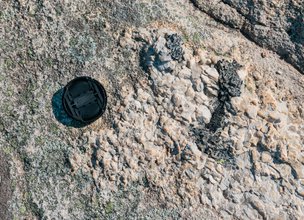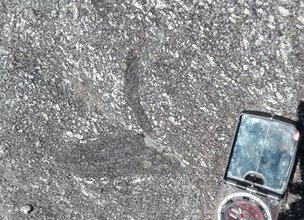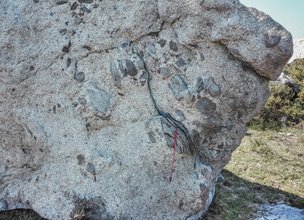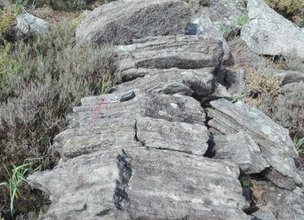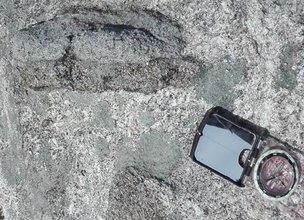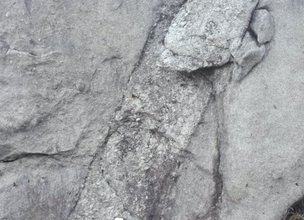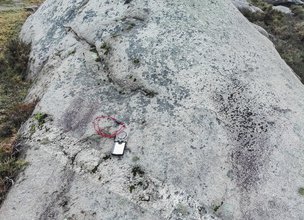Granitic rocks.
Granitic rocks have an igneous (or magmatic) origin and are the result of slow cooling and crystallization of magma some kilometres deep. Rocks that form in this way are called intrusive.
There are different types of magma, and therefore the chemical and mineralogical composition of granitic rocks may also vary a lot. The most common minerals in granitic rocks are quartz and feldspar (orthoclase, plagioclase), which are always present. Minerals like mica (biotite and moscovite), amphibole, garnet, among others, may be part of granites or not.
A granite is petrologically defined as a rock where quartz can vary between 20 and 60% and plagioclase between 10 and 60% of the total amount of quartz+alcaline feldspar+plagioclase. Granitic rocks are usually hard, homogeneous and crystalline, and with a reduced primary porosity.
The rate of cooling is also responsible for originating different rocks. Slow cooling allows minerals to grow thus giving rise to rocks that possesse crystals several centimeters long. As a consequence, granitic rocks may present different types of minerals and a variety of textures (texture is related to the size of the minerals).
In the LNM “Granite Plateau of Chãs de Santa Luzia”, two main types of granite can be found. They were emplaced during the Variscan orogeny, which had its maximum about 300 million years ago (esq. A). In the northern part of the LNM, occurs a fine to medium grained porphyroid granite that was emplaced during the second phase of the Variscan orogeny: the Bouça de Frades granite. In the southern part of the LNM, occurs the Afife granite, which is medium to coarse grained, and was emplaced during the third phase of the same orogeny. In the south west, there is a variation of the Afife granite with a fine to medium grained two micas facies. All the granite facies have quartz, K-feldspar, biotite, apatite, zircon, and sillimanite. Tourmaline and garnet occur exclusively in the facies in the south west part of the LNM (Fig. 1).
The distribution of granites in the field reflects the age of their emplacement: the most recent at the base, corresponding to the third phase of the Variscan orogeny, and above the ancient ones, corresponding to the second phase of the orogeny. The granites were emplaced in a regional antiform named Viana do Castelo – Caminha (AVCC) Antiform (Pamplona, 2001; Pamplona e Ribeiro, 2013).
The most outer layer of planet Earth (lithosphere) is formed by moving tectonic plates giving rise to three types of boundaries: convergent boundaries, when plates move into one another; divergent boundaries, when they move apart, and transform boundaries, when moving sideways in relation to each other.
The creation and destruction of tectonic plates are processes that take place during millions of years since the beginning of Earth’s history. Plates are usually created in the middle of continents originating oceans – where sediments resulting from the erosion of continents form sedimentary rocks – and after their closure the collision of continents gives rise to mountain ranges (orogeny). Each of these sequences corresponds to a geological cycle also named Wilson Cycle.
Several geological cycles – with about 500 million years each since the initial opening to the orogenic phase – took place in the past, as can be verified in rock outcrops that exist today in the surface of the Earth. Most of rocks that occur in Portugal are associated with the last two orogenic cycles, Variscan and Alpine.
The geological backgroud that was structured during the Variscan cycle is called Iberian Massif and is the main geological backbone of the Iberian Peninsula. At the borders of the Iberian Massif (Lusitanian and Algarvian basins) or in its inside depressions (Douro, Tejo, Sado, Ebro and Guadalquivir basins) sediments formed rocks during the Alpine cycle (opening of the Atlantic ocean), which is still developing with colliding phases that give rise to today most significant mountain ranges.
The Iberian Massif corresponds to (sedimentary) rocks that were formed during the oceanic phase of the orogenic cycle and after transformed into metamorphic rocks. In this phase, several generations of granite plutons were placed in depth and today they outcrop in large areas of Portugal.
Granites that occur in this LNM and surrounding regions must be understood in the context of the Variscan orogeny. Their current emplacement at the surface reveals the long erosion endured by rocks of the Iberian Massif during the last 300 million years. This process was reinforced by the regional tectonic uplift that took place during the Alpine orogeny (esqs. B and C).
The Bouça de Frades granite has some xenoliths with micas and other minerals of metasedimentary origin. This circumstance reveals that these rocks were emplaced at the top of the granitic pluton and near the surrounding metasedimentary rocks. Near the top of Santa Luzia mountain there are remains of metasedimentary structures (Desejosa formation) included in granite outcrops. In the Afife granite, xenoliths of the fine grained Bouça de Frades granite can be found, which represents a latter emplacement of the former (Figs. 2 to 5).
It is also in the Afife granite that pegmatite veins can be found, some of them about 1 meter thick with minerals such as garnet, tourmaline and beryl (Figs. 6 and 7).
References:
Pereira, P; Henriques, R.; Brilha, J. & Pereira, D.I. (2019). Conteúdos científicos para a caracterização dos 8 monumentos naturais locais” enquadrado no projeto Geoparque Litoral de Viana do Castelo – 2ª fase. Município de Viana do Castelo, Relatório Final GEOSITE, 273 p.
Granitic rocks have an igneous (or magmatic) origin and are the result of slow cooling and crystallization of magma some kilometres deep. Rocks that form in this way are called intrusive.
There are different types of magma, and therefore the chemical and mineralogical composition of granitic rocks may also vary a lot. The most common minerals in granitic rocks are quartz and feldspar (orthoclase, plagioclase), which are always present. Minerals like mica (biotite and moscovite), amphibole, garnet, among others, may be part of granites or not.
A granite is petrologically defined as a rock where quartz can vary between 20 and 60% and plagioclase between 10 and 60% of the total amount of quartz+alcaline feldspar+plagioclase. Granitic rocks are usually hard, homogeneous and crystalline, and with a reduced primary porosity.
The rate of cooling is also responsible for originating different rocks. Slow cooling allows minerals to grow thus giving rise to rocks that possesse crystals several centimeters long. As a consequence, granitic rocks may present different types of minerals and a variety of textures (texture is related to the size of the minerals).
In the LNM “Granite Plateau of Chãs de Santa Luzia”, two main types of granite can be found. They were emplaced during the Variscan orogeny, which had its maximum about 300 million years ago (esq. A). In the northern part of the LNM, occurs a fine to medium grained porphyroid granite that was emplaced during the second phase of the Variscan orogeny: the Bouça de Frades granite. In the southern part of the LNM, occurs the Afife granite, which is medium to coarse grained, and was emplaced during the third phase of the same orogeny. In the south west, there is a variation of the Afife granite with a fine to medium grained two micas facies. All the granite facies have quartz, K-feldspar, biotite, apatite, zircon, and sillimanite. Tourmaline and garnet occur exclusively in the facies in the south west part of the LNM (Fig. 1).
The distribution of granites in the field reflects the age of their emplacement: the most recent at the base, corresponding to the third phase of the Variscan orogeny, and above the ancient ones, corresponding to the second phase of the orogeny. The granites were emplaced in a regional antiform named Viana do Castelo – Caminha (AVCC) Antiform (Pamplona, 2001; Pamplona e Ribeiro, 2013).
The most outer layer of planet Earth (lithosphere) is formed by moving tectonic plates giving rise to three types of boundaries: convergent boundaries, when plates move into one another; divergent boundaries, when they move apart, and transform boundaries, when moving sideways in relation to each other.
The creation and destruction of tectonic plates are processes that take place during millions of years since the beginning of Earth’s history. Plates are usually created in the middle of continents originating oceans – where sediments resulting from the erosion of continents form sedimentary rocks – and after their closure the collision of continents gives rise to mountain ranges (orogeny). Each of these sequences corresponds to a geological cycle also named Wilson Cycle.
Several geological cycles – with about 500 million years each since the initial opening to the orogenic phase – took place in the past, as can be verified in rock outcrops that exist today in the surface of the Earth. Most of rocks that occur in Portugal are associated with the last two orogenic cycles, Variscan and Alpine.
The geological backgroud that was structured during the Variscan cycle is called Iberian Massif and is the main geological backbone of the Iberian Peninsula. At the borders of the Iberian Massif (Lusitanian and Algarvian basins) or in its inside depressions (Douro, Tejo, Sado, Ebro and Guadalquivir basins) sediments formed rocks during the Alpine cycle (opening of the Atlantic ocean), which is still developing with colliding phases that give rise to today most significant mountain ranges.
The Iberian Massif corresponds to (sedimentary) rocks that were formed during the oceanic phase of the orogenic cycle and after transformed into metamorphic rocks. In this phase, several generations of granite plutons were placed in depth and today they outcrop in large areas of Portugal.
Granites that occur in this LNM and surrounding regions must be understood in the context of the Variscan orogeny. Their current emplacement at the surface reveals the long erosion endured by rocks of the Iberian Massif during the last 300 million years. This process was reinforced by the regional tectonic uplift that took place during the Alpine orogeny (esqs. B and C).
The Bouça de Frades granite has some xenoliths with micas and other minerals of metasedimentary origin. This circumstance reveals that these rocks were emplaced at the top of the granitic pluton and near the surrounding metasedimentary rocks. Near the top of Santa Luzia mountain there are remains of metasedimentary structures (Desejosa formation) included in granite outcrops. In the Afife granite, xenoliths of the fine grained Bouça de Frades granite can be found, which represents a latter emplacement of the former (Figs. 2 to 5).
It is also in the Afife granite that pegmatite veins can be found, some of them about 1 meter thick with minerals such as garnet, tourmaline and beryl (Figs. 6 and 7).
References:
Pereira, P; Henriques, R.; Brilha, J. & Pereira, D.I. (2019). Conteúdos científicos para a caracterização dos 8 monumentos naturais locais” enquadrado no projeto Geoparque Litoral de Viana do Castelo – 2ª fase. Município de Viana do Castelo, Relatório Final GEOSITE, 273 p.
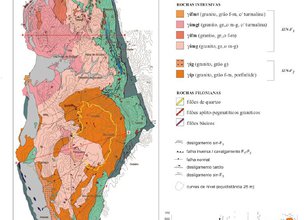
Esq. A - Geological map of the northern coast of Viana do Castelo. The boundaries of the Local Natural Monument “Granite Plateau of Chãs de Santa Luzia” are in yellow. Adapted from Pamplona (2001).
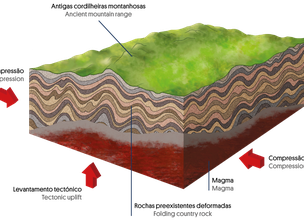
Esq. B - Scheme of the model that explains the placement of granitic plutons during Variscan orogeny and their current disposition.
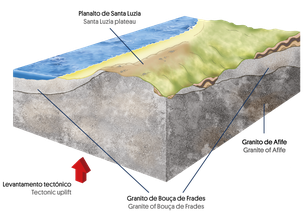
Esq. C - Scheme of the model that explains the placement of granitic plutons during Variscan orogeny and their current disposition.
Location
Serra de Sta. Luzia
Coordinates
Lat: 41.7557434
Long: -8.8223065
Hello little one!
I'm Piquinhos and I can help you learn more about the Geopark!
Technical details
Esq. A - Geological map of the northern coast of Viana do Castelo. The boundaries of the Local Natural Monument “Granite Plateau of Chãs de Santa Luzia” are in yellow. Adapted from Pamplona (2001).
Esq. B - Scheme of the model that explains the placement of granitic plutons during Variscan orogeny and their current disposition.
Esq. C - Scheme of the model that explains the placement of granitic plutons during Variscan orogeny and their current disposition.
Child Mode
Discover the geopark in a simpler format, aimed at the little ones.
Clique ENTER para pesquisar ou ESC para sair
